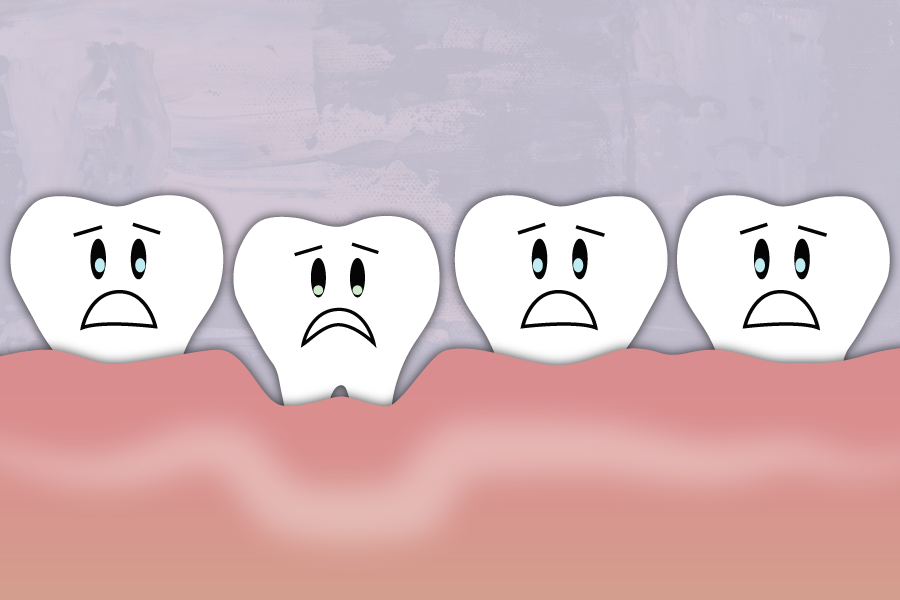Can Receding Gums Grow Back Naturally?
By Shelby Tatomir on December 17, 2019 in Dental Health

Our mouth heals faster than many other parts of the body. You may have noticed this when you have bit your tongue or cheek. But, unfortunately, this rapid healing doesn’t apply to our gum tissue. If our gum tissue recedes, that means the tissue pulls back, exposing more of the tooth and potentially the tooth’s root surface. Healthy gums fit snugly around a tooth, protecting it. The gums stop protecting when they move away from the biting surface of the tooth toward the tooth root. A gap or pocket may form between part of the tooth and the gumline. Harmful bacteria have an easier time accessing the tooth through this gap, leading to more decay, and possibly tooth loss. So, what causes receding gums and how can they be avoided?
What Causes Receding Gums?
The American Dental Association says that there isn’t a clear connection between the way people brush their teeth and receding gums. Gum disease from poor oral health habits is actually a proven cause of receding gums. Three out of every four adults have gum disease and many don’t even know it.
Gum disease starts when plaque builds up on our teeth and gums. When the plaque is not removed daily, the bad bacteria in the plaque irritate and inflame our gum tissue. The protective tissue that holds our teeth in place is now compromised. Eventually the inflammatory process, or puffiness, redness, and swelling can destroy the gum tissue. This causes spaces called pockets to form. These pockets make room for even more bacteria, making the infection worse.
Early on, gum disease or gingivitis will look like red, swollen gums that bleed easily. If you’re keeping up on your dental visits, your dentist should recognize this. A thorough cleaning can help reset your oral health if you continue to maintain healthy brushing and flossing habits.
Click here to find a dentist near you.
If gum disease isn’t treated and gets worse, it can lead to what is called periodontitis. When gum disease gets this bad, your dentist may refer you to a special dentist called a periodontist.
In advanced stages of periodontitis, the gums aren’t able to keep teeth in place, causing them to become loose, fall out, or require removal by a dentist. “Periodontitis is the culprit in 70 percent of tooth loss in adults over age 40.” The good news is that your dentist and periodontist can help prevent this and help you choose the best daily oral health care routine.
Treatments to Reverse Receding Gums
Maintaining good preventive care helps keep our mouths healthy. But if gum disease occurs, your dentist has different levels of treatment available to make sure you can get back to a healthy mouth and smile. The goal of each treatment is the same: eliminate plaque, reduce bacterial activity, and protect the teeth from further damage.
Scaling and root planing, or debridement - Your dentist or hygienist will carefully use their special tools to remove plaque and tartar that is gathering above and below the gum line. They may use a manual scaler or an ultrasonic instrument. This is known as “scaling” or “deep scaling.”
If damaged tissue is present, the dentist or hygienist may also remove it to help with the healing process. After they have cleaned the gum line thoroughly and removed infection-causing bacteria, they will move on to the final step, which is called root planing.
Root planing – This smooths out your tooth’s root surface. Root planing also aids in the healing process, making it easier for new, healthy gum tissue to reattach easily. If you’re concerned about pain, discuss with your dentist if these procedures can be performed under local anesthesia.
Drug therapy - Short courses of oral antibiotics, as well as antibiotic and antiseptic medications applied directly to the gums, can reduce bacteria and inflammation.
Surgery - Occasionally with moderate to advanced disease, the periodontist must surgically remove the degenerated gum tissue and reduce the depth of the pocket. Surgery is recommended only in cases where it will prevent the loss of the tooth and when more conservative measures have failed to stop the progression of the disease.
Maintenance is key. After any initial treatment, plaque levels must be kept low to avoid a resurgence of the disease. A good plan includes visiting the dentist or hygienist every three months, brushing and flossing without fail, and using an antimicrobial mouth rinse.
Just like the rest of our body, if your mouth has an infection like gum disease, it’s important that an oral health care practitioner is able to clean out the bad stuff to kick start a successful healing process. Not only do regular dental cleanings prevent an infection from getting worse, the process can relieve inflammation and discomfort and reduce bad breath.
If you are experiencing any of these symptoms or haven’t been to the dentist in a while, click here to find one near you.
Looking for a dental plan to help you maintain a healthy mouth and smile? Click here.